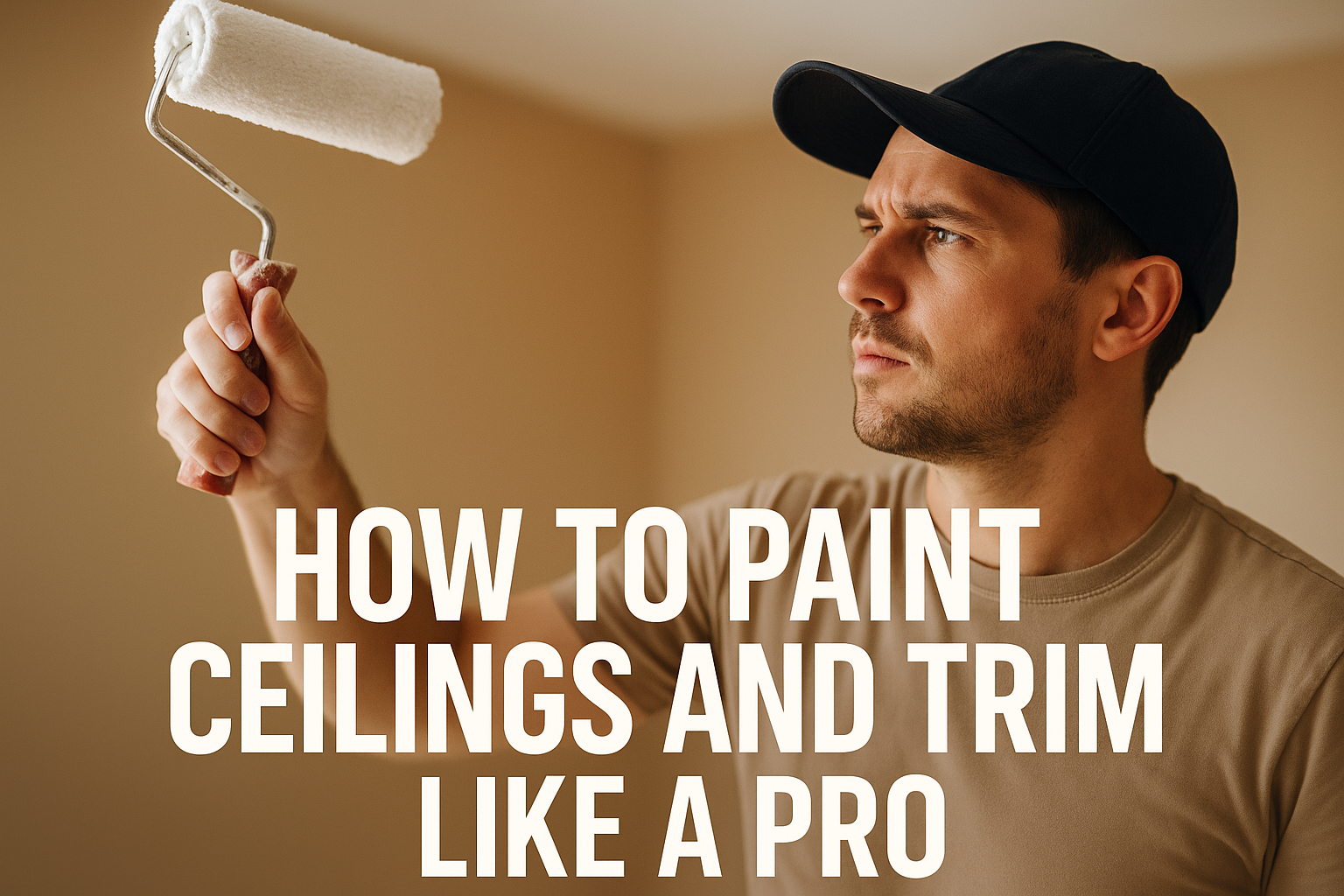One of the simplest and most cost-effective ways to update your home is by painting the walls inside your house. Of course, you can do everything required to change the perception and the appearance of the room and do that with a minimal number of tools and the appropriate attitude.
You can paint the walls like a pro regardless of whether it is your first time or you wish to improve your DIY skills as a way of getting smooth and lasting results on the walls. This guide will take you through each procedure of preparation as well as methods, color options and maintenance.
How to Prepare a Room Before Painting Walls
Steps to Get Your Room Ready for Painting
Before you even open the paint can, preparation makes the difference. An organized and clean area makes the painting process quicker and more effective.
Here’s how to get started:
- Ease the room: Take out furniture in the room where possible. Otherwise, put it all in the middle and wrap it.
- Clean wall: Clean walls by eliminating frames, hooks and covers to light switches.
- Check the walls: It is necessary to check holes, cracks, and peeling paint and fix them to paint them again.
- Wipe down: Grease and dust may prevent the adherence of paint. Wipe down walls using a light soap and water.
- Tape edges: Taping trim, window frames and baseboards with painter tape.
This is a basic preparation work that makes sure that the walls are even and that the paint will stick evenly.
Tools and Materials You’ll Need to Paint a Room
It is easier to paint when someone has the right tools. You’ll need:
- Paint (any type of paint you wish to use)
- Roller covers and roller rollers
- Paint brush (angled on edges)
- Painter’s tape
- Paint tray
- Plastic sheets or drop cloths.
- Sandpaper (to rub surfaces)
- Primer (if needed)
- Ladder or step stool
Get your material ready before you begin, so that you can access everything easily. It will save time and frustration later.
How to Protect Furniture and Floors Before Painting
The dripping paint is experienced even by professional painters. Furniture and flooring are also protected, which ensures that there is no stress of cleaning.
- Place plastic covers or lay drop cloths on the floor.
- Wrap furnishings in old clothes or plastic covers.
- Place painter’s tape or use it to cover up the window and trim around the edges.
- Put newspaper or cardboard below paint cans and trays.
Even a minor shield removes a lot of dirt in your area..
How to Paint a Wall Step by Step
Cleaning and Repairing the Walls
Walls should be clean and smooth before painting. Holes or dirt may destroy the final appearance.
- Clean any dirt using a moist sponge and a weak cleaner.
- Apply spackle over small holes or cracks and sand them when they dry.
- Allow walls to dry first before painting or priming.
Walls that are kept clean also contribute to the increased sticking of paint and a smooth finish.
Applying Primer for Better Paint Results
Primer assists in the development of a smooth surface particularly when your walls are stained or when you are switching to a light color.
- Large areas should be rolled and corners brushed.
- One layer of primer is applied and allowed to dry.
- After drying, sand rough areas slightly.
The right primer enhances paint color and makes it more uniform.
How to Cut In Edges Like a Pro Painter
There is a term known as cutting that is used to refer to the process of brushing the edges and corners first, then rolling the walls afterward. This provides you with clean lines.
- Only the slight tip of your brush should be dipped into the paint.
- Begin a few inches away along the edge, and then proceed towards the line.
- Draw in long, straight lines, rather than in short dots.
It may be a long process but that is what makes your paint job look good.

Rolling Paint on Walls Evenly
The exciting part is now the rolling of paint on your walls!
- Paint your roller with paint in a tray and roll it over.
- Begin at the midpoint on the wall and roll upwards in a W or M shape.
- Light and overlapping strokes fill in the gaps.
Do not press very hard, leave the roller to it. This makes the coverage continuous and eliminates streaks.
When and How to Apply a Second Coat
The majority of walls require two coats to be covered.
- Allow the first coating to be completely dry (normally 2-4 hours).
- The second coat should be applied in the same direction as the first
- Make sure you test thin areas and fill them in then clean your tools.
In the better part, take your time here to guarantee long lasting smooth finish.
Best Techniques for Painting Walls Smoothly
How to Avoid Roller Marks and Paint Lines
Roller marks are the occurrence when the paint dries unevenly. To avoid them:
- Never leave a wet edge (never stop partway up the wall).
- Work in small sections.
- Apply a right roller nap to your wall.
- Re-rolling of semi-dry paint should be avoided.
Smooth, steady strokes create a seamless look.
Tips for Even Coverage and Clean Edges
- Apply good brushes and rollers so that they apply paint better.
- Combine all the paint cans in one bucket to cause a uniform color.
- Peeling can be prevented by removing painter’s tape when the paint is still a little wet.
- You should also maintain light to view the spots that you have missed.
Your best friends are good tools and patience.
Painting Tricks Professionals Use
Amateurs of painting have a few tricks to achieve a perfect result:
- Between coats, wrap brushes and rollers in plastic to avoid drying.
- Big walls are to be used with an extension pole rather than a ladder.
- Begin at the top and wipe under drips, proceeding downwards.
- Apply paint on ceilings, then on walls, and lastly on trim.
These are just the habits that will make your work look like that of a professional.
How to Choose the Right Paint for Interior Walls
Best Paint Colors for Living Rooms, Bedrooms, and More
The process of selecting color may be overwhelming, but the following is a general tip:
- Living Rooms: The warm coloring of such neutral tones as beige, cream, or soft gray has been achieved.
- Bedrooms: Relaxation is assisted by the calming blue, green, or lavender tones.
- Kitchens: Whites or yellows maintain the brightness and freshness of things.
- Bathrooms: Light aqua or soft gray has a fresh and airy feel.
It is always a good idea to sample the paint on your wall so as to get an idea of how the paint will appear under varying light conditions.
Choosing Between Matte, Satin, and Gloss Finishes
Every finish is of its own style and use:
- Matte: Non-reflective, soft, conceals flaws best in the bedroom.
- Satin: Light luster, easy to clean perfect in hallways and living rooms.
- Gloss: Smooth and durable to use in trimming, doors and kitchens.
Choose a finish that suits the use of your room and the lighting.
How Paint Finish Affects the Look of a Room
- Bright colors and finishes are shinier and more reflective.
- Flat finishes form a relaxed and comfortable impression.
- The middle finish (satin or eggshell) is slightly glowed without being very bright.
The mixture of finishes such as matte walls and gloss trim gives the finish depth and visual interest.
Drying, Touch-Ups, and Wall Care Tips
How Long Does Paint Take to Dry Between Coats
The various drying times are based on humidity and the type of paint:
- Latex paint: 2-4 hours coating to coating.
- Paint based on oil: 6-8 hours between layers.
Never place a second coat on before verifying the label first on how it is to dry.
How to Fix Missed Spots After Painting
Inspect walls after the light has set in.
- Apply a small brush or roller to touch up areas that have been missed.
- Lightly mix the new paint with the medium.
- Light layers cannot be smoothed when they are heavily applied.
Your paint job becomes perfect with proper touch-ups.

Easy Maintenance Tips for Painted Walls
To preserve the appearance of your walls:
- Wipe with a cotton cloth.
- Spot cleaning should be done using mild soap and water.
- Strong chemicals that do not sharpen the finish should be avoided.
- Store unused paint in a container to fix it very easily.
Basic maintenance allows your paint job to be beautiful and not to fade after a few years.
Common Mistakes When Painting a Room
What to Avoid for a Smooth Finish
Avoid these common pitfalls:
- Skipping the use of primer on dark or stained walls.
- Painting too much onto your roller.
- Painting during extreme weather conditions.
- With low-priced brushes, shedding bristles.
- Jumping right through coats before they soak.
Taking things slow and ensuring that every move is correct will result in pro-quality work.
Simple Fixes for Painting Errors
In case something goes wrong, do not panic:
- Drips: Spray sand and repaint.
- Spots: Use a second thin coat.
- Edges peeling: Peel away the tape when the paint is still tacky.
- Color discrepancy: Swirl paint before reworking.
The professional errors are not the solution; what is important is how to correct them.
Conclusion
What it takes to be an expert at painting inside walls is not all about the technique, but whether to be patient and prepared. The key to having the perfect finish is having the right tools, clean surfaces and a steady hand so it appears professionally done.
Each step could count in the outcome, and it is possible to select the appropriate shade of paint, apply smooth layers, etc.
Knapp Painting is the place to go to find more professional tips on painting or hire a professional to do the interior painting.
FAQs
Preparation of the space is the first step in this process, including dusting furniture, taping edges, and patching holes in the wall before you paint it.
Not always. Apply primer when you are painting over dark colors or stains or new drywall.
Two coats tend to be complete and smoother.
Allowing the paint to dry takes 2-4 hours, or more as long as it remains sticky to the touch.
The easiest to wipe down and maintain are the satin and semi-gloss finishes.













